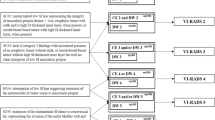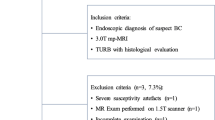Abstract
Purpose
To assess the diagnostic performance of biparametric magnetic resonance imaging (bp-MRI) in predicting detrusor muscle invasion for bladder cancer (BC) located at the ureteral orifice by comparing it with the Vesical Imaging Reporting and Data System (VI-RADS) system based on multiparametric MRI (mp-MRI).
Methods
Patients with histopathologically proven BC located at the ureteral orifice from December 2019 to November 2022 were analyzed retrospectively. Two sets, bp-MRI (set 1) and mp-MRI (set 2), were formed from the images. Both sets were evaluated independent of histopathology by three radiologists with different levels of experience in abdominal radiology. Receiver operating characteristic (ROC) curve analysis was used to assess the diagnostic performance of VI-RADS in the prediction of muscle invasion. The intraclass correlation coefficient (ICC) was used to evaluate inter-reader agreement.
Results
Of 68 patients with BCs located at the ureteral orifice, 50 (48 males, median age: 72 years) met the study criteria. Out of the 50 patients, 36 had non-muscle invasive BC (pTa–T1) and 14 had muscle invasive BC (MIBC) (pT2–T4). In the comparison of VI-RADS categories with histopathologic data for MIBC detection, the area under the curve of the ROC analysis for the bp- and mp-MRI protocol was 1.000–0.986 for reader 1, 0.893–0.901 for reader 2, and 0.808–0.865 for reader 3. There was no statistically significant difference in predicting detrusor muscle invasion with the bp- and mp-MRI-based on VI-RADS categories for all readers (p = 0.126, 0.203, and 0.322, respectively). The ICCs between all the readers showed excellent agreement and were similar for both protocols.
Conclusion
The bp-MRI consisting of DWI and T2-WI can be used as an alternative to the mp-MRI in predicting detrusor muscle invasion for BCs located at the ureteral orifice; however, less experienced readers should exercise caution.
Graphical abstract





Similar content being viewed by others
Availability of data and material
Data generated or analyzed during the study are available from the corresponding author by request.
Code availability
Not applicable.
References
Bray F, Ferlay J, Soerjomataram I, et al. (2018) Global cancer statistics 2018: GLOBOCAN estimates of incidence and mortality worldwide for 36 cancers in 185 countries. CA Cancer J Clin 68:394–424. https://doi.org/10.3322/caac.21492.
Soukup V, Čapoun O, Cohen D, et al. (2017) Prognostic performance and reproducibility of the 1973 and 2004/2016 World Health Organization grading classification systems in non–muscle-invasive bladder cancer: A European Association of Urology Non-muscle invasive bladder cancer guidelines panel systematic review. European Urology 72:801–813. https://doi.org/10.1016/j.eururo.2017.04.015
Linton KD, Rosario DJ, Thomas F, et al. (2013) Disease specific mortality in patients with low risk bladder cancer and the impact of cystoscopic surveillance. The Journal of urology 189:828–833. https://doi.org/10.1016/j.juro.2012.09.084.
Josephson D, Pasin E, Stein JP. (2007) Superficial bladder cancer: part 2. Management. Expert review of anticancer therapy 7:567–581. https://doi.org/10.1586/14737140.7.4.567.
Witjes JA, Comperat E, Cowan NC, et al. (2014) EAU guidelines on muscle-invasive and metastatic bladder cancer: summary of the 2013 guidelines. Eur Urol 65:778–792. https://doi.org/10.1016/j.eururo.2013.11.046.
Kulkarni GS, Hakenberg OW, Gschwend JE, et al. (2010) An updated critical analysis of the treatment strategy for newly diagnosed high-grade T1 (previously T1G3) bladder cancer. Eur Urol 57(1):60–70. https://doi.org/10.1016/j.eururo.2009.08.024.
Babjuk M, Bohle A, Burger M, et al. (2017) EAU guidelines on nonmuscle- invasive urothelial carcinoma of the bladder: update 2016. Eur Urol 71:447–461. https://doi.org/10.1016/j.eururo.2016.05.041.
van der Pol CB, Sahni VA, Eberhardt SC, et al. (2018). ACR Appropriateness Criteria ® Pretreatment Staging of Muscle-Invasive Bladder Cancer. J Am Coll Radiol 15(5S):150–159. https://doi.org/10.1016/j.jacr.2018.03.020.
Caglic I, Panebianco V, Vargas HA, et al. (2020) MRI of Bladder Cancer: Local and Nodal Staging. J Magn Reson Imaging 52(3):649-667. https://doi.org/10.1002/jmri.27090.
Panebianco V, Narumi Y, Altun E, et al. (2018) Multiparametric magnetic resonance imaging for bladder Cancer: development of VI-RADS (Vesical imaging-reporting and data system). Eur Urol 74(3):294–306. https://doi.org/10.1016/j.eururo.2018.04.029.
Delli Pizzi A, Mastrodicasa D, Marchioni M, et al. (2021) Bladder cancer: do we need contrast injection for MRI assessment of muscle invasion? A prospective multi-reader VI-RADS approach. Eur Radiol. 31(6):3874-3883. https://doi.org/10.1007/s00330-020-07473-6.
Aslan S, Cakir IM, Oguz U, et al. (2022) Comparison of the diagnostic accuracy and validity of biparametric MRI and multiparametric MRI-based VI-RADS scoring in bladder cancer; is contrast material really necessary in detecting muscle invasion?. Abdominal radiology (New York) 47(2):771–780. https://doi.org/10.1007/s00261-021-03383-3.
Wang H, Luo C, Zhang F, et al. (2019) Multiparametric MRI for bladder Cancer: validation of VI-RADS for the detection of detrusor muscle invasion. Radiology 291(3):668–674. https://doi.org/10.1148/radiol.2019182506.
Ueno Y, Tamada T, Takeuchi M, et al. (2021) VI-RADS: Multiinstitutional Multireader Diagnostic Accuracy and Interobserver Agreement Study. Am J Roentgenol. 216(5):1257-1266. https://doi.org/10.2214/AJR.20.23604.
Metwally MI, Zeed NA., Hamed EM, et al. (2021) The validity, reliability, and reviewer acceptance of VI-RADS in assessing muscle invasion by bladder cancer: a multicenter prospective study. European radiology 31(9):6949–6961. https://doi.org/10.1007/s00330-021-07765-5.
Cai Q, Ling J, Kong L, et al. (2022) Multiparametric MRI Evaluation of VI-RADS for Bladder Tumors Located at the Ureteral Orifice. Radiology, 304(3):593–599. https://doi.org/10.1148/radiol.220028.
Kbirou A, Hagguir H, Moataz A, et al. (2022) Acute renal failure and bladder tumors, about 106 cases. Nephrologie & therapeutique 18(3):202–206. https://doi.org/10.1016/j.nephro.2021.10.005.
Campbell GA, Hu D, Okusa MD. (2014) Acute kidney injury in the cancer patient. Advances in chronic kidney disease 21(1):64–71. https://doi.org/10.1053/j.ackd.2013.08.002.
Pecoraro M, Takeuchi M, Vargas HA, et al. (2020) Overview of VI-RADS in Bladder Cancer. AJR. American journal of roentgenology 214(6):1259–1268. https://doi.org/10.2214/AJR.20.22763.
Stephenson WT, Holmes FF, Noble MJ, Gerald KB. (1990) Analysis of bladder carcinoma by subsite Cystoscopic location may have prognostic value. Cancer 66(7):1630–1635. https://doi.org/10.1002/1097-0142(19901001)66:7<1630::aid-cncr2820660730>3.0.co;2-7.
Wong-You-Cheong JJ, Woodward PJ, Manning MA, Davis CJ (2006) From the archives of the AFIP: Inflammatory and nonneoplastic bladder masses: radiologic-pathologic correlation. Radiographics : a review publication of the Radiological Society of North America, Inc 26(6):1847–1868. https://doi.org/10.1148/rg.266065126.
Fujii Y, Fukui I, Kihara K, et al. (1998) Significance of bladder neck involvement on progression in superficial bladder cancer. European urology 33(5):464–468. https://doi.org/10.1159/000019636.
Woo S, Suh CH, Kim SY, et al. (2017) Diagnostic performance of MRI for prediction of muscle-invasiveness of bladder cancer: a systematic review and meta-analysis. Eur J Radiol 95:46–55. https://doi.org/10.1016/j.ejrad.2017.07.021.
Arita Y, Shigeta K, Akita H, et al. (2020) Clinical utility of the Vesical imaging-reporting and data system for muscle-invasive bladder cancer between radiologists and urologists based on multiparametric MRI including 3D FSE T2-weighted acquisitions. Eur Radiol 31: 875-883. https://doi.org/10.1007/s00330-020-07153-5.
Hong SB, Lee NK, Kim S, et al. (2020) Vesical imaging-reporting and data system for multiparametric MRI to predict the presence of muscle invasion for bladder Cancer. J Magn Reson Imaging 52(4):1249–1256. https://doi.org/10.1002/jmri.27141.
van der Pol CB, Chung A, Lim C, et al. (2018) Update on multiparametric MRI of urinary bladder cancer. J Magn Reson Imaging 48:882–896. https://doi.org/10.1002/jmri.26294.
Funding
No funding was received for this study.
Author information
Authors and Affiliations
Contributions
UE—Conceptualization; Data curation; Formal analysis; Investigation; Methodology; Project administration; Resources; Validation; Visualization; Roles/Writing—original draft; Writing—review and editing. MNT—Conceptualization; Investigation; Resources; Visualization. SA—Formal analysis; Investigation; Visualization; Writing—review and editing. Supervision.
Corresponding author
Ethics declarations
Conflict of interest
The authors declare that they have no conflict of interest.
Informed consent
Due to its retrospective design, we waived the requirement for informed consent.
Ethical approval
All procedures performed in studies involving human participants were in accordance with the ethical standards of the institutional research committee and the 1964 Declaration of Helsinki and its later amendments or comparable ethical standards. This retrospective study was approved by Institutional Review Board.
Consent to participate
Due to its retrospective design, we waived the requirement for informed consent.
Consent for publication
Yes.
Additional information
Publisher's Note
Springer Nature remains neutral with regard to jurisdictional claims in published maps and institutional affiliations.
Rights and permissions
Springer Nature or its licensor (e.g. a society or other partner) holds exclusive rights to this article under a publishing agreement with the author(s) or other rightsholder(s); author self-archiving of the accepted manuscript version of this article is solely governed by the terms of such publishing agreement and applicable law.
About this article
Cite this article
Eryuruk, U., Tasdemir, M.N. & Aslan, S. Comparison of the diagnostic performance of biparametric and multiparametric MRI in detecting muscle invasion of bladder cancer located at the ureteral orifice. Abdom Radiol 48, 3174–3182 (2023). https://doi.org/10.1007/s00261-023-03979-x
Received:
Revised:
Accepted:
Published:
Issue Date:
DOI: https://doi.org/10.1007/s00261-023-03979-x




